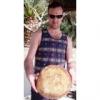Links to my fellow baker's in the Bread Baker's Apprentice Challenge, 2011! Here are links to their versions of this bread. They are all very talented baker's, who have gotten together to share their results from baking the Bread's in Peter Reinhart's book Bread Baker's Apprentice.
Our host Chris at A Ku Indeed!
I will post others as they finish theirs!
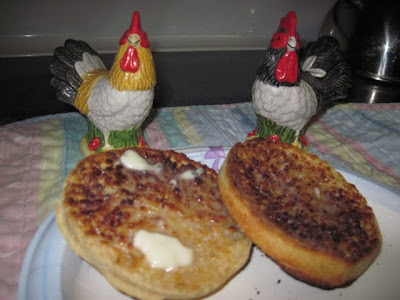 Today is the day for making my first English muffins. I know that Andy will love these, in fact he has been waiting for these since Christmas. Really I should have done them sooner, but there have been so many recipes to try and things to do that I just hadn't gotten to it. Another storm rolled in last night giving us a ton of rain followed by a skiff of snow overnight, which means it's pretty chilly in the house today, so it's another perfect baking day!
English muffins and crumpets always remind me of a time years ago when I was a young teen. My mom took me to a small tea house and we sat and talked while we ate English muffins toasted with crab and jack cheese melted on top. We each had a cup of fancy tea, and it was such a good day. I remember feeling very grown up. That is a memory I will never forget, one of those times when you know that your mom loves you and wants to be with you.
She asked for the recipe for those crab and cheese topped English muffins, and would make them occasionally throughout my teen years. I can't remember if we had crumpets that day, but they also bring memories of growing up. They always have butter and honey on them, and simply make my mouth water and my brain transports back to my childhood. I think I will make them next....
Today is the day for making my first English muffins. I know that Andy will love these, in fact he has been waiting for these since Christmas. Really I should have done them sooner, but there have been so many recipes to try and things to do that I just hadn't gotten to it. Another storm rolled in last night giving us a ton of rain followed by a skiff of snow overnight, which means it's pretty chilly in the house today, so it's another perfect baking day!
English muffins and crumpets always remind me of a time years ago when I was a young teen. My mom took me to a small tea house and we sat and talked while we ate English muffins toasted with crab and jack cheese melted on top. We each had a cup of fancy tea, and it was such a good day. I remember feeling very grown up. That is a memory I will never forget, one of those times when you know that your mom loves you and wants to be with you.
She asked for the recipe for those crab and cheese topped English muffins, and would make them occasionally throughout my teen years. I can't remember if we had crumpets that day, but they also bring memories of growing up. They always have butter and honey on them, and simply make my mouth water and my brain transports back to my childhood. I think I will make them next....
Everything in it's place, so very organized. Now if you know me well, you will realize that the bowl is sitting on another counter with everything except the buttermilk/kefir in it. I started to put things away, when I realized I hadn't taken a picture of it so I hastily grabbed it all together in one spot and took a "pretty" picture so you would all think "She is so organized!". I am the one that has to rerun the recipe in my head a dozen times to make sure that I didn't leave anything out.

Here are the dry ingredients all added together. I adjusted the recipe by using 50% fresh ground Winter White Wheat rather than all bread flour, replaced the sugar with honey, and used kefir in place of buttermilk. I normally use the baker's percentages for the BBA recipes, but this time the recipe only made 6 English muffins which I figured we would eat pretty quickly. I weighed everything according to the book, and used measuring spoons for the honey, salt and yeast.

I went ahead and put the entire 8 oz of kefir into the flour mix, figuring if it was to wet then I would simply add a little flour.

It was looking pretty sticky at this point, so I allowed it to autolyse for half an hour. This seems to help a lot, especially when working with whole wheat flours.
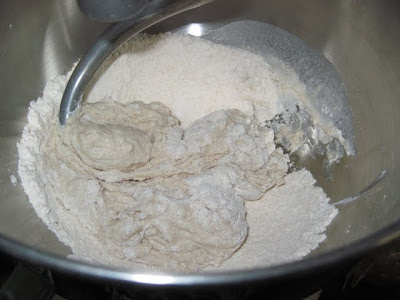
What starts out very sticky, ends up quite manageable after kneading it for 6 minutes after it's 30 minute nap. Here it is, with the bowl looking all clean on the sides. I love when dough has this consistency, just makes it so easy to work with.

Time to scoop it out of the bowl and form it into a boule. I will let it rise for 90 minutes, possibly a little longer because it's cold in the kitchen today.

It looks so small in the container I use to do the first rise. Getting used to recipes that make a large amount of dough, which I usually reduce down to 2 lb so I don't get over run!

Here it is after it's first rise, ready to be gently removed from it's jar and carefully made into small boule's.


It just seems like such a small amount of dough to me!

Wow, only a little over a pound of dough!

I have these cool English muffin rings that I got for Christmas and have been wanting to try. I sprinkled semolina into the rings after I sprayed the parchment paper with oil. The rings have shortening on them, to keep them from sticking.
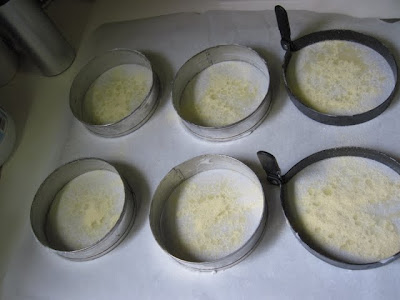
Dough has risen for 90 minutes, ready to fry!!!!

Things were looking pretty good at this point and I decided to fry three with rings off and three with rings on. I put the muffins into the pan, and then pulled the rings off these ones. They immediately started to spread slightly in the pan. I fried them for 6 minutes, and when I turned them over they were burnt on that side! Yuck, my pan was to hot even though it was set to the temp in the book. I then turned it down 50 degrees, and hoped for the best. I fried that side for 5 minutes.

Here are the three I fried with the rings on, including when I flipped them over.
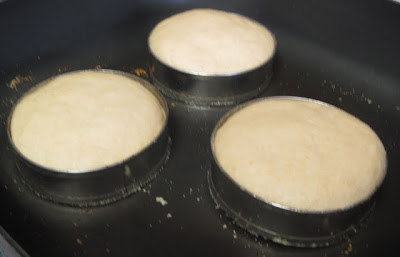
At that point I took the rings off, and continued frying them. The pan was a much better temp, and I fried them for 8 minutes on each side.

Here they are all ready to cool off and then to eat. They look pretty good!

Crumb shot....






